In October of 1987, NASCAR driver Michael McDowell found himself in a challenging situation at the Talladega Superspeedway. During a race, McDowell’s car suddenly veered off course and crashed into the wall, leaving him in a prime position to be hit by other drivers on the track. In an interview reflecting on the incident, McDowell shared his thoughts on what he could have done differently to prevent such a dangerous situation from occurring.
McDowell began by acknowledging the role that communication plays in ensuring driver safety on the track. He emphasized the importance of clear communication between drivers, spotters, and race officials to avoid potential accidents and keep everyone safe. McDowell noted that in the case of his crash at Talladega, better communication could have helped him avoid being in the path of other vehicles on the track.
In addition to communication, McDowell highlighted the need for better training and preparation for unexpected situations on the race track. He emphasized the importance of practicing emergency maneuvers and being able to think quickly on your feet in high-pressure situations. McDowell acknowledged that in the heat of the moment, it can be challenging to make split-second decisions, but thorough preparation and training can help drivers respond effectively to unexpected events.
Reflecting on his own experience at Talladega, McDowell admitted that there were certain actions he could have taken to prevent the crash from escalating. He acknowledged that staying calm and focused in the face of danger is crucial for driver safety, and he recognized that he could have done a better job of maintaining his composure during the incident. McDowell emphasized the importance of remaining level-headed in high-stress situations and making rational decisions to ensure the safety of oneself and others on the track.
Moreover, McDowell discussed the importance of learning from past mistakes and using them as opportunities for growth and improvement. He acknowledged that every race presents unique challenges and obstacles, and it is essential for drivers to reflect on their experiences and identify areas for improvement. McDowell emphasized the value of self-reflection and continuous learning in the world of professional racing, noting that even seasoned drivers can benefit from reviewing their performances and seeking ways to enhance their skills on the track.
In conclusion, McDowell’s reflections on the incident at Talladega underscore the importance of communication, training, composure, and continuous learning for ensuring driver safety in NASCAR. By emphasizing these key principles, McDowell offers valuable insights for aspiring drivers and racing enthusiasts looking to navigate the challenges of competitive racing. McDowell’s willingness to acknowledge his mistakes and share his insights serves as a reminder of the ongoing commitment to safety and professionalism in the high-speed world of professional racing. Overall, McDowell’s words are a testament to the dedication and perseverance required to succeed in the fast-paced and competitive environment of NASCAR.















